School of Health Sciences
Occupational Hygiene
Occupational Medicine
Supervisor/Marker
Dissertation Guidance
CONTENTS
INTRODUCTION
This document outlines the services each dissertation supervisor/marker will be asked to deliver to the MSc programmes within the Division of Population Health.
Please use this document in conjunction with the relevant programme’s Dissertation Guide and the Ethics Guidance Guide, if applicable.
KEY CONTACTS
Anne Clayson, Programme Director (Occupational Hygiene) anne.clayson@manchester.ac.uk
Melanie Carder, Programme Director (Occupational Medicine) melanie.carder@manchester.ac.uk
Programme administration team pgt-coeh@manchester.ac.uk
IT SIGN-UP AND ACCESS
All external members of staff delivering a service to our programmes at the University of Manchester will have access to the University’s IT facilities; thus MUST complete IT Sign-Up for computing facilities.
The IT Account Manager allows external/new staff to sign up for the central IT account and provides additional self-service account management features for all IT users at the University of Manchester.
If you haven’t already activated your account, please follow the steps below:
- Go to: https://iam.manchester.ac.uk
- Click ‘Activate your IT account’
- Start IT Signup
- Enter your surname, date of birth and University ID number (obtainable from your programme administration team)
- Click ‘Search’
- You will receive a username (mzy….) which you require to access University systems, such as the Ethical Review Manager system (ERM) and Blackboard to access course materials, dissertation submissions, etc.
You can also use the IT Account Manager to recover your IT account, if you have forgotten your username and/or password.
SUPERVISORY PROCESS
- A 60-credit postgraduate taught dissertation is expected to involve a student in 600 hours of study.
- As a supervisor of a 60-credit dissertation (10,000 – 15,000 words), you will normally provide 20 hours of supervision.
4.1 Frequency of Contact
Supervisor time is allocated to making contact, providing guidance, marking and feedback. Whilst we rely on your professional judgment about frequency of contact and how much time is required, we expect supervision of a dissertation to be regular and frequent (at least once per month with more frequent intervals particularly in the early stages of planning and developing research and data collection methods). It is up to you which methods of contact are preferred including direct interaction such as Zoom/Teams, telephone or email discussion. Between supervision sessions, it is likely that students will have questions and we expect supervisors to respond within five working days, but more rapid responses are preferable. We suggest you negotiate and clarify expectations at the outset, including any periods when you or the student will be unavailable. Please notify your programme admin team in advance if you know you will be out of regular contact for two weeks or more.
Some students (including those undertaking the 2 year part-time or one year full-time programme of study) may be studying course units together with their dissertation. We ask them to notify you so that you are aware of their additional workload and possible impact on the dissertation.
4.2 Dissertation Length
A 60-credit dissertation is usually 10,000-15,000 words in length, excluding appendices and bibliography (please refer to Appendix I: Word Count Guide). A dissertation over 15,000 words requires permission from the Programme Director. Appendices are to be used for reference purposes, to check accuracy of data, and may include a glossary of terms; appendices are not for elaboration and we do not expect you to mark appendices.
4.3 Ethics
It is expected that the supervisor will fully engage with the ethics review process to help assess whether ethical approval is required and if so, by which route, and to ensure that disciplinary norms are adhered to in all instances. The supervisor is responsible for assessing the level of ethical risk with the student, reviewing all ethics documentation prior to submission (and offering suggested improvements if necessary) and signing off on the final application. The supervisor is also required by the University to be the data custodian for the project and should be listed as such on the ethics documentation.
Supervisors will be fully supported by the programme director in this process and will have access to a comprehensive guide detailing the different steps of the ethical review process. Additional resources, for example, training material delivered by the University’s Research Governance, Ethics and Integrity Team, are also available.
4.4 The Supervisor’s Responsibilities
As a supervisor, you should help your student in a variety of ways during the development of and writing the dissertation:
- Help define the precise problem to be tackled and advise on its suitability and the scope of the work.
- Provide regular critique and advice. Feedback will be focused and specific, with clear identification of strengths, gaps, and suggestions for particular improvements.
- Explain ethical issues, confidentiality and other professional responsibilities.
- Provide feedback in a timely fashion. Informal feedback or comments on a short report will be provided more quickly (5 working days).
- Offer guidance on literature and data sources and help with access to library materials.
- Offer guidance on relevant techniques and assistance with problems in analytical work.
- Give advice on data gathering and its analysis and interpretation.
- Give comprehensive advice on how to keep the work focused, suggesting areas requiring deeper discussion and advice on the structure of the dissertation.
- Provide guidance on presenting the dissertation.
- Comment on drafts and sections of the dissertation.
- Keep records and report on progress; maintain an audit trail. Recommend dissertation related decisions, such as extensions, change to dissertation topic: these recommendations require formal approval.
- Formal comments on final submission of the dissertation must be submitted to Blackboard within 30 working days.
4.5 The Student’s Responsibilities
The dissertation must always be thought of as the student’s own work. They should provide the driving force behind the dissertation. You can reasonably expect the student to:
- Maintain regular contact with the supervisor, ideally at least monthly contact.
- Identify and refine the topic selection and objectives.
- Plan according to the key deadlines and the timeline for submission.
- Manage their time and submit work as planned.
- Take account of feedback and guidance.
- Seek and act on advice regarding ethical and professional responsibilities.
- Gain prior approval for surveys, interviews schedules, and other data collection methods.
- Locate and agree arrangements with client organisations for any fieldwork to be conducted in an organisational setting. Agree with both the client organisation and the supervisor appropriate means for protecting and storing sensitive and confidential information.
- Bear the costs of the work, including fieldwork, communicating with your supervisor, and printing.
- Keep records and report on progress.
4.6 Extensions
Supervisors may request an extension to submit on the student’s behalf following consultation with the student or should support a student’s request for an extension to submit, where there is justification, usually due to mitigating circumstances. Request for an extension must be submitted to the Programme Admin team, together with documentary evidence, for example a doctor’s letter, sick note, supporting statement from the Dissertation Supervisor, etc. for School consideration.
Late submission of the dissertation (i.e. where an extension has not been agreed) will result in late submission penalties being applied as set out in the student Dissertation Guide.
4.7 Attendance Monitoring
The following guidance outlines the requirements of the School in relation to the monitoring of attendance and engagement for part-time PGT students during the research component of a Masters level degree. This is in accordance with the University’s expectations in monitoring attendance (Regulation XX – Monitoring Attendance and Wellbeing of Students.
- Full and part-time PGT students are required to maintain regular contact with their dissertation supervisor throughout the research component of their degree.
- The School’s expectation is that there is a minimum of one contact point per month. This can be via email, telephone, Zoom/Teams, face-to-face, etc.
- The attendance/engagement of PGT students must be recorded by the main supervisor.
- The Programme Admin team will request confirmation from the main supervisor on a monthly basis that the PGT student has adhered to the required attendance/engagement points.
- Where a student fails to attend/engage on two consecutive months or where a pattern of non-attendance/engagement becomes apparent it is the main supervisor’s responsibility to notify the Programme Director and Programme Admin team immediately.
- Where students are identified as meeting one of the above trigger points, the process as outlined in section 4 of the University’s ‘Policy on Recording and Monitoring Attendance’ will be employed.
4.8 Use of dissertation for clients and publication
The aims of the Dissertation is to satisfy the MSc programme aims and outcomes. As this is an independent piece of work with specific learning outcomes, students may want to circulate their finished work to other organisations. Revised versions of the dissertation must not be available to external organisations until all marking and feedback has been completed (first marking, second marking and moderation). The student may not have the final mark but should be given the feedback comments on the dissertation, and should use these comments to make essential amendments to correct errors and improve accuracy if they are to circulate their work outside of the University of Manchester. Markers should bear in mind the need for feedback for this purpose. We appreciate any support and advice that supervisors can provide in the production of a report version suitable for external parties.
Some students may wish to write their dissertation for a professional journal, or occasionally for an academic journal. University of Manchester students are bound by Intellectual Property obligations. For example, if an external organization has made data available to the student, and they intend to use those data for purposes other than their MSc award, then that organisation may have reasonable expectations regarding confidentiality. If a student is interested in publishing their work, they need written permission from any other parties who were involved in their dissertation. If they intend to submit a piece for publication, they will need to get a written sign-off of permission before submitting. You may wish to co-author with your students.
supervisor and student responsibilities
The initiative for requesting supervision lies entirely with the student. The supervisor’s role is to give advice and help on the nature and standard of the work and direct the student to useful literature and appropriate methodology.
The impetus for arranging meetings rests with the student. However, if they do not contact you within the first two weeks then please contact them. Remember that you can only guide the student’s writing and rescue them from major inadequacies if you have seen the text. It is recommended that students send you sections of their dissertation, with a note indicating stage of completion and draft contents, as soon as they complete them and the whole draft at least one month before the final submission date.
Please note that you are not to be expected to proofread or correct spelling/grammar. However, it is expected that you give feedback on the writing quality. You should make a judgement on whether it is suitable for the MSc level. Where there are concerns with writing quality, you should refer your concerns to the Programme Director as soon as possible. There is a vast range of support available for student in writing and presentation of work. The University’s Presentation of Dissertations Policy can be accessed here.
5.1 Good practice in supervision
Each supervisor-student relationship will be different, but there are some common elements that we recommend as good practice.
- Go through the Dissertation guidance with the student, to clarify the dissertation aims, processes and expectations.
- Make sure both you and the student have a common understanding of the dissertation objectives and methods.
- Agree the expected frequency of contact between you and the student.
- Both the student and supervisor should provide adequate prior notification of periods of unavailability or absence from the dissertation.
- Discuss a contingency plan in case the dissertation does not proceed as planned.
- Be aware that you are agreeing to the defined aims and objectives as the supervisor. Colleagues are available to assist should you require further discussion.
Ensure to communicate with the student frequently. Regular, frequent, in-depth contact will help the student progress and identify mistakes and poor writing style at an early stage.
5.2 Period of Supervision
The period of supervision is dependent on the programme that the student is registered on. Therefore, please refer to the programme’s Dissertation Handbook/Guide.
turnitin & ACADEMIC MALPRACTICE
Academic malpractice covers all kinds of academic dishonesty but the main forms are plagiarism, self-plagiarism, collusion, and falsification or fabrication of results.
6.1 Using Turnitin to detect academic malpractice
Turnitin is an automated text matching tool that checks the similarity of students’ assessed course work to other sources such as journal articles, book chapters and web pages, as well as the work of other students at the University of Manchester and universities across the world.
Turnitin provides a similarity score that indicates the extent to which an assignment has text that matches other sources, which is colour coded:
- Blue = No matching words
- Green = 1 word – 24% matching text
- Yellow = 25% – 49% matching text
- Orange = 50% – 74% matching text
- Red = 75% – 100% matching text
6.2 What Turnitin does not do?
Turnitin does not detect academic malpractice (e.g., plagiarism, collusion, fabrication) but helps the marker to decide if academic malpractice has occurred.
Turnitin cannot detect cheating, such as when someone else writes a student’s assignment.
6.3 How should I interpret a Turnitin % score?
Determining whether academic malpractice is present in the work of a student is a matter for academic judgement. Turnitin is a useful tool which can help an academic make this decision more quickly and confidently but is not a substitute for academic judgement.
A key question that should be asked in suspected cases of academic malpractice is: Does the suspected case look like evidence of poor academic practice that could best be dealt with by a mark penalty and formative feedback, or is there evidence of an intention to deceive?
What might evidence of poor academic practice look like?
The definition of academic malpractice (Academic Malpractice Procedure, p2) is “any activity – intentional or otherwise – that is likely to undermine the integrity essential to scholarship or research”.
In some cases, the evidence might indicate a poor understanding of what is expected on the part of the student. This poor understanding could be because the student has received too little advice and formative feedback on their writing, because the assignment instructions were unclear, or simply because the student is a weak student. Forcing such cases through a formal disciplinary process is unlikely to be a good way to help a student to improve his or her practices. Evidence of poor referencing might be:
- The suspected source for matched text is present in the bibliography but not cited or acknowledged at the appropriate point in the text.
- The suspected source is not acknowledged as a direct quotation but some attempt at citation/reference is evident.
- What is matched is connecting or structural text, or descriptive or technical information (e.g. background information describing a company or technology) rather than substantive work – review, analysis, synthesis or conclusions.
- The student has paraphrased a section of text poorly but has made an attempt to cite the appropriate reference.
6.4 What should I look out for when considering whether malpractice has occurred?
It is not possible to provide a threshold Turnitin score above which it can be stated that academic malpractice has occurred. It is possible that an assignment with a relatively low score (especially a long assignment, such as a dissertation or project report) might contain serious plagiarism whilst an assignment with a relatively high score might, on close inspection, be considered to be legitimate work.
Evidence of a deliberate attempt to deceive might include:
- The extensive use of text from one source or a number of sources, with the suspected source(s) not listed in bibliography.
- The use of many small but unreferenced pieces of text from other sources.
- Secondary citations from the source copied over and those cited sources listed in bibliography.
- Text matched to one source but attributed to another.
- Matches in review, analysis, synthesis, results or conclusions sections.
- Data or findings from another study presented as the students’ own (falsification)
- Long unreferenced passages of copied text in which a few words have been changed, e.g. by using synonyms.
6.5 What factors might increase a Turnitin score but not be evidence of academic malpractice?
Certain factors can increase a Turnitin score considerably but they might not be evidence of academic malpractice, particularly in short assignments. These are:
- References.
- Common phrases or academic terms.
- The assignment question included in the text.
- Output from software programmes that is automatically created, e.g., the footnotes of SPSS tables.
6.6 Is Turnitin fallible?
Yes, is the short answer. It cannot detect cheating and it can only check an assignment against sources that are online and in a format that is readable.
6.7 Are scores of 0% suspect too?
A score of 0% can be achieved by a student submitting work in a format that cannot be read by Turnitin. By doing this a student could submit an assignment that contains academic malpractice and still get a score of 0%. If a score of 0% is recorded, it is worth checking if the assignment has been submitted in a readable format.
6.8 What about matches to other student work?
Care should be taken to investigate suspected matches identified by Turnitin to work submitted to the University of Manchester or to other universities in detail before any action is taken. Turnitin will not automatically allow you to see the piece of work to which the match has been made but will allow you to request this from the relevant School/University – which you should always do.
There are a number of known issues that have arisen with such matches:
- Work previously submitted by the same student to a different course unit – this could be considered as self-plagiarism.
- Work previously submitted by the same student to a different university – as above.
- Innocuous matches – matches might include the essay question, common references, common datasets for quantitative assignments, quoted and attributed information in boxes or appendices.
- Apparent collusion disguising underlying plagiarism – two or more student papers may both plagiarise a third source. The matches identified by Turnitin depend on the order in which the material has been added to the database. This can often be clarified by exploring the underlying matches using the appropriate facility in Turnitin.
- False cumulative matches –Turnitin reports aggregate all matches to papers from the same institution under a single heading “University of Manchester paper” (or similar). We have seen cases where a seemingly substantial match has turned out to be the aggregate of many innocent 1-2% matches to different student papers. This can be discounted by exploring the underlying matches using the appropriate facility in Turnitin.
Turnitin may not automatically allow you to see work by other students, particularly from other universities, but will allow you to request this from the relevant university.
6.9 Data fabrication and falsification
Fabrication is making up data or results and recording or reporting them.
Falsification is manipulating research materials, equipment, or processes, or changing or omitting data or results such that the research is not accurately represented in the research record. Falsification also includes the selective omission/deletion/suppression of conflicting data without scientific or statistical justification.
When reading the report both markers should take a mildly critical (sceptical) view of empirical evidence – it is for the student(s) to convince the reader that it is genuine:
- Are there suspicious patterns in summaries of ‘questionnaire responses’ suggesting that it has been made-up? Or that a small sample has been replicated many times to make it appear larger?
- Is other people’s work being explicitly or implicitly presented as students’ own work – even if just through ambiguous language.
As above, markers MUST pursue a serious case through Malpractice on the grounds of Data Fabrication. More minor (but still material) SHOULD be explicitly commented on and an explicit marks penalty may be imposed
Examples of types of statements:
- “I am suspicious of the empirical data reported in this project. There are unusual patterns in the summary of questionnaire responses and there is no evidence or discussion that these are the result of genuine responses. I am submitting evidence for a malpractice case on the basis of data fabrication.”
For ‘created’ data, it will be more powerful if some probability estimates are made for the chance the pattern is a fluke.
- “A report available on the internet has been used (cited and referenced), but the way some material from it is presented implies it is the students’ own empirical work.”
Misattribution should be marked up in the report and source – as for plagiarism
You can read more information on how to understand and interpret a Turnitin report on Plagiarism by clicking here.
6.10 How to Submit a Case of Suspected Academic Malpractice
Should you suspect academic malpractice, please contact the Programme Director and Senior Programme Administrator who will be able to provide you with further guidance on how to refer a case.
accessING the dissertation IN BLACKBOARD
Students no longer submit a hard copy of their dissertation but are now required to submit online, to the University’s Virtual Learning Environment (VLE) – Blackboard, and are subject to the plagiarism detection software – Turnitin.
Once logged into the POPH69000 Dissertation 2022-23, navigate to Course Management down the left hand menu > Grade Centre > click on your group name:
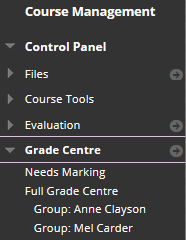
You will see the list of students that you are supervising:

The ![]() symbol indicates that the student has submitted their dissertation.
symbol indicates that the student has submitted their dissertation.
To access the submission, hover the mouse over the cell of where the symbol is and click the drop down arrow:
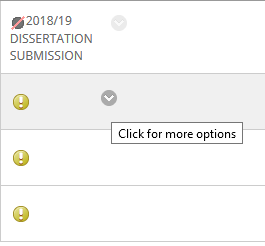
Click ‘Attempt DATE’:
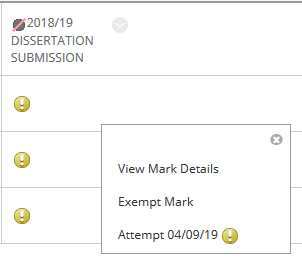
This will now take you to the ‘Modify Grade’ screen where you can access the ‘User’s Work’, download the ‘User’s Paper’ and ‘Similarity Report’ by clicking the ![]() symbol as shown below (opens in a new window):
symbol as shown below (opens in a new window):

It is imperative that you DO NOT click on the ‘Clear Attempt’ button as this will permanently remove the student’s submission.
ONLINE MARKING IN BLACKBOARD
Marking of dissertations is undertaken in accordance with the University’s regulations and will be independently marked by two examiners. Usually the supervisor will act as the first marker and has overall responsibility for finalising and submission of the Dissertation Examiner Report Form and mark for the dissertation to Blackboard.
The marking turnaround times are tight and we need you to observe deadlines or students risk not being presented to the Exam Board. You are expected to mark and provide feedback within 30 working days of final submission through Blackboard. This also includes second marking and third marking, if required.
As a supervisor/marker, you will be expected to keep up to date with changes to course content and methods including technology, and should take part in relevant training.
The supervisor may also be expected to second mark one or more of another supervisor’s dissertation as part of the supervisory responsibility. As per the Marking & Moderation Guidelines, a sample of dissertations will be moderated by the Programme External Examiner.
8.1 Dissertation Examiner Report Form, Comments and feedback
The Dissertation Examiner Report Form can be downloaded from Blackboard within the Dissertation Unit Examiner Guidance area. The assigned supervisor is normally Examiner No.1 and you will be notified who examiner No.2 is (sometimes this could be a co-supervisor).
When marking the dissertation, we expect you to provide sufficient comments to justify all aspects of your mark. As a rough guide you should expect to provide approximately one or two paragraphs related to each of the marking criteria.
Comments must be included together with your marking in Blackboard.
Use the full spread of marks but at the extremes, at or below 50 (fail) or over 80, provide detailed justification. For a fail, explain in detail what the student needs to do to improve and achieve a Pass mark. Where marks over 80, explain what is excellent or exceptional. Please avoid marks ending in 9. Give guidance on amendments required before presenting a dissertation to the client organisation.
8.2 Markers’ Responsibilities
The supervisor is responsible for:
- completing their own marking.
- liaison with the second marker.
- managing the marking by the second marker.
- negotiating and agreeing the final mark with the second marker.
- updating the examiner report form with 2nd marker feedback/marks, the agreed mark feedback and final agreed mark.
- ensuring that all marks and feedback are showing correctly on the Examiner report form.
- upload completed examiner form to Blackboard following negotiation between markers.
- requesting a third marker where a mark is not negotiable between first and second marker.
- liaison with the moderator, as appropriate.
- meeting marking deadlines.
- following up and acting on the moderator’s recommendations, if any.
- academic malpractice referral to Programme Director and Programme Manager.
The second marker is responsible for:
- completing their own marking.
- negotiating and agreeing the final mark with the supervisor.
- meeting marking deadlines.
- following up and acting on the moderator’s recommendations, if any.
8.3 Uploading the Dissertation Examiner Report Form and Mark
After each marker has assessed the dissertation independently they must agree a final mark. It will be the supervisor’s responsibility to combine the supervisor and second marker’s feedback/marks onto one Dissertation Examiner Report Form and then include the final agreed mark/record of the discussion. The supervisor will then upload the form and enter the final total mark in Blackboard (see instructions below).
The feedback and mark will be released to the students within the marking turnaround period of 30 working days from the submission due date. Students will be made aware that the feedback and mark is provisional until ratified by the Exam Board.
Uploading Examiner Feedback forms for Dissertation
- Go to the Full grade centre and scroll across to the column called ‘Final inbox dissertation ’, then down through the students you will see the submission (exclamation mark showing it needs marking).
- Click the grey drop down arrow next to the exclamation mark and select ‘view mark details’
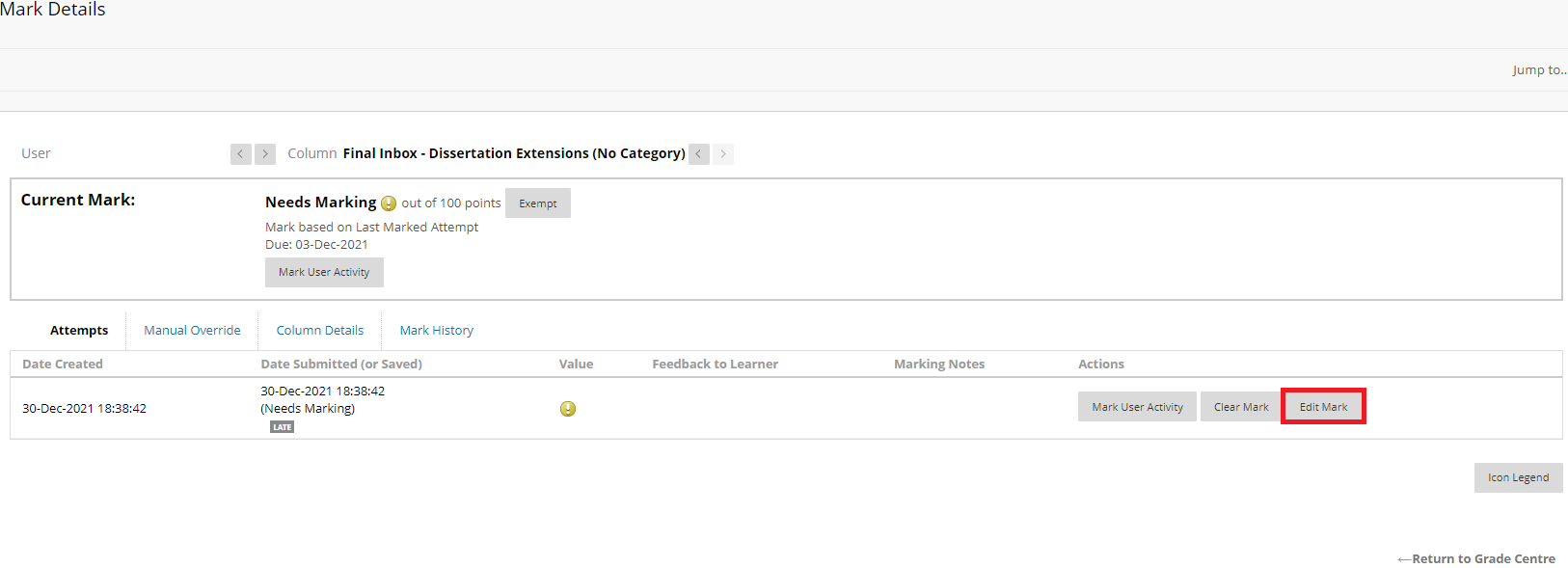
- Click ‘Edit Mark’ and this screen will open
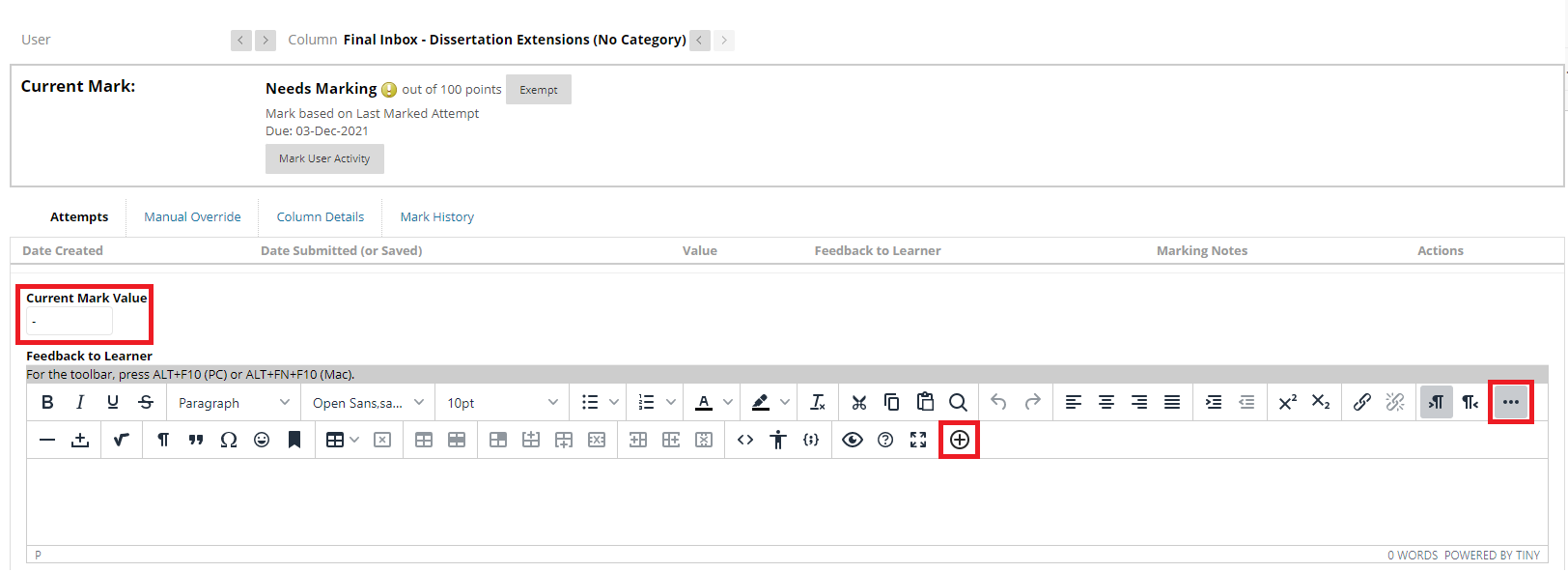
- Now insert the agreed final mark into the ‘Current Mark Value’ box
- Next click ‘…’ in the feedback to learner section which opens more options
- Next click the
 and the option to add a file opens, select ‘Insert Local Files’
and the option to add a file opens, select ‘Insert Local Files’
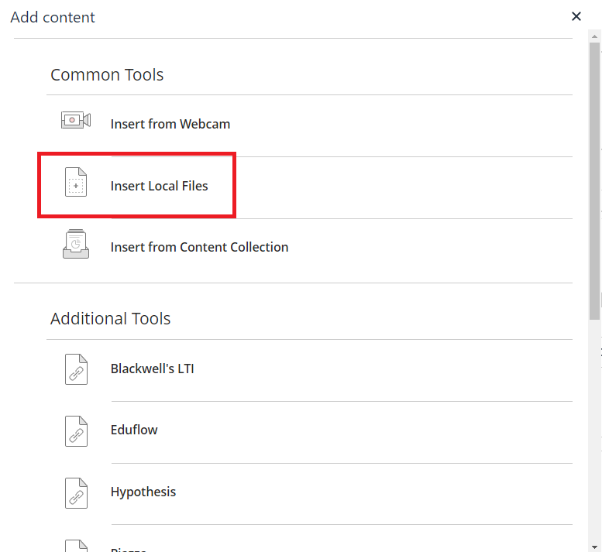
You will see the file appear in the ‘Feedback to Learner’ section. Then click ‘save’ ![]()
Then you can click ‘Return to Grade Centre’ in the bottom right of the screen. ![]()
Should you experience any difficulty with this process please contact PGT-COEH@manchester.ac.uk for support.
MARKING CRITERIA
The following table gives a breakdown of the standard required to achieve a grade within a particular marking band:
| Mark | Explanation | |
| 90-100% | Exceptional (allows award of distinction):
Exceptional work, nearly or wholly faultless for that expected at Master’s level. Perfect presentation. |
|
| 80-89% | Outstanding (allows award of distinction): Work of outstanding quality throughout. Excellent presentation. | |
| 70-79% | Excellent (allows award of distinction): Work of very high to excellent quality showing originality, high accuracy, thorough understanding, critical appraisal. Shows a wide and thorough understanding of the material studied and the relevant literature and the ability to apply the theory and methods learned to solve unfamiliar problems. Very good presentation. | |
| 60-69% | Good Pass (allows award of merit): Work of good to high quality showing evidence of understanding of the research topic, good accuracy, good structure and relevant conclusions. Shows a good knowledge of the material studied and the relevant literature and some ability to tackle unfamiliar problems. Good presentation. | |
| 50-59% | Pass: Work shows a clear grasp of relevant facts and issues and reveals an attempt to create a coherent whole. It comprises reasonably clear and attainable objectives, adequate literature review and some originality. Presentation is acceptable, minor errors allowed. | |
| 40-49% | Referral: Work shows a satisfactory understanding of the research topic and basic knowledge of the
relevant literature but with little or no originality and limited accuracy. Shows clear but limited objectives, and does not always reach a conclusion. Presentation adequate but could be improved. |
|
| 30-39% | Referral: Work shows some understanding of the main elements of the research topic and some knowledge of the relevant literature. Shows a limited level of accuracy with little analysis of data or attempt to discuss its significance. Presentation poor. | |
| Students starting their programme: | ||
| From September 2012 | From September 2016 | |
| 20-29% | Referral: Limited relevant material presented. Little understanding of research topic. Unclear or unsubstantiated arguments with very poor accuracy and understanding. Presentation unacceptable. | Fail with no opportunity to resubmit: Limited relevant material presented. Little understanding of research topic. Unclear or unsubstantiated arguments with very poor accuracy and understanding. Presentation unacceptable. |
| 10-19% | Referral: Limited understanding of the research process. The topic is largely without evidence to support its exploration for research and the arguments are supported by poor sources of evidence. The dissertation is disjointed and does not demonstrate logical coherent thinking with unacceptable presentation. | Fail with no opportunity to resubmit: Limited understanding of the research process. The topic is largely without evidence to support its exploration for research and the arguments are supported by poor sources of evidence. The dissertation is disjointed and does not demonstrate logical coherent thinking with unacceptable presentation. |
| 0-9% | Referral: The text demonstrates no
understanding of the research process. The topic is totally inappropriate and there is no evidence to support its exploration as an area of interest for research. Presentation is extremely poor and is not in an appropriate format for submission as a Master’s dissertation. The topic would need to be reconstructed and totally rewritten if it were to be presented for resubmission. |
Fail with no opportunity to resubmit: The text demonstrates no understanding of the research process. The topic is totally inappropriate and there is no evidence to support its exploration as an area of interest for research. Presentation is extremely poor and is not in an appropriate format for submission as a Master’s dissertation. The topic would need to be reconstructed and totally rewritten if it were to be presented for resubmission. |
APPENDICES
Appendix I: Word Count Guide
What is and what is not included in the word count:
| Title page | No |
| Contents | No |
| List of tables, figures | No |
| Glossary of Terms | No |
| Page numbers | No |
| Abstract | No |
| Declaration | No |
| Intellectual Property | No |
| Acknowledgements | No |
| Introduction | Yes |
| Background, Critical Review of Existing Literature | Yes |
| Aims | Yes |
| Methods | Yes |
| Results | Yes |
| Discussion | Yes |
| Conclusions | Yes |
| Recommendations | Yes |
| Citations in the main text | Yes |
| Directly quoted material in the main text | Yes |
| List of References | No |
| Appendices | No |
| Tables and Figures | The titles, footnotes and citations for
Tables and Figures are included but the actual text within them is not |

